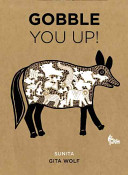2018 School Spending Survey Report
Gobble You Up!
, adapt. Gobble You Up! illus. by Sunita. 40p. Tara Bks. 2013. Tr $29.95. ISBN 9788192317144.
COPY ISBN
After gulping down animal after animal, greedy Jackal bursts (he survives, as do his victims). It's a surefire tale made splendid by gorgeous illustrations and bookmaking. Meticulously, the art is silkscreened onto sturdy kraft paper and hand bound. The tactile effect of the flat silkscreen on the faintly mottled paper is a treat--a true work of art.
The outline is familiar: after gulping down animal after animal, a greedy creature bursts. Here it's a jackal who devours the dozen fish his best friend the crane has caught for him, then the crane herself, and so on, all neatly cumulated in Wolf's exuberant adaptation of a Hindi tale from Rajasthan: "Proud peacock / Lost her poise / Quiet cat / Just annoys-- / Gobbled you up, / Elephant! / Did you really / Think I couldn't?" Unlike the old lady who swallowed a fly, the jackal survives his bursting, as do his victims. (The fate of a tailor bird who may stitch the jackal back up is more uncertain.) It's a surefire tale made splendid by gorgeous illustrations and bookmaking. According to a note, Sunita uses a traditional art form passed from mothers to daughters, squeezing chalk and lime paste through her fingers to paint ritual motifs, especially animals. Some of these originally white images (particularly the jackal) are rendered here in black, in elegant counterpoint to the remaining white. As creatures accumulate in the jackal's belly, the stylized forms are cleverly, and beautifully, re-formed and rearranged, to excellent effect. Meticulously, the art is silkscreened onto sturdy kraft paper by a dozen printers (credited by name), and hand bound (the binders are also named). The tactile effect of the flat silkscreen on the faintly mottled paper is a treat--a true work of art. Yes, this is pricey, but it's worth every penny. joanna rudge long
ALREADY A SUBSCRIBER? LOG IN
We are currently offering this content for free. Sign up now to activate your personal profile, where you can save articles for future viewing





Be the first reader to comment.
Comment Policy:
Comment should not be empty !!!